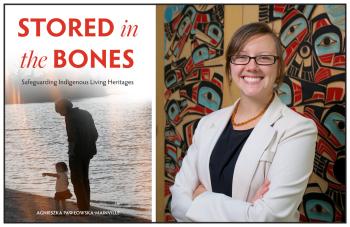Image Caption
Summary
Local Journalism Initiative Reporter
Windspeaker.com
Until federal politicians start “valuing people in their own homes”, intangible cultural heritage will remain misunderstood and underappreciated, said Agnieszka Pawlowska-Mainville, author of Stored in the Bones.
“They always assume that intangible cultural heritage has something to do with materials, museums, archives, when really sometimes it just means valuing people in their own homes. Like a grandmother teaching her grandson or granddaughter how to cook, a father using his own hands with his own niece, nephew to do some kind of carving or some kind of sewing. It's that element that I think (there’s) a lot of misunderstanding about,” said Pawlowska-Mainville, an associate professor in First Nations Studies at the University of Northern British Columbia.
In Stored in the Bones, published late last year by University of Manitoba Press, Pawlowska-Mainville mixes the rich stories of her Indigenous guides—including Anishinaabe/Ojibwe medicine man Richard Morrison, Poplar River trapper Abel Bruce, and Inninu trapper Noah Massan–with the practical aspects of preserving intangible cultural heritage. Their oral storytelling is an example of cultural heritage preservation, as all three men passed away before the book was published.
“They would be so happy that their stories are documented,” said Pawlowska-Mainville.
It was Morrison who told Pawlowska-Mainville that “in the old language, people understood aadizookaan to also mean ‘spirit, inside. Inside my bones.’ Aadizoo is a life experience of the ancestors. People who tell stories, who know stories so well they are stored in your bones.”
Pawlowska-Mainville recalled having that conversation with Morrison. She said it reminded her of a song that is sung in her native Poland on Independence Day about a soldier coming home and the moss in the forest covering his bones after he dies. That conversation “sparked” something within her and led to the title of the book.
“Bones are tangible, but really they're only made or given life the moment they're stored in people, and the people carry them, and they carry the songs and the stories…The bones are just the material manifestation of our humanity and our human storage capacity of all these different cultural elements that… keep the cultural heritage alive,” she said.
In 2003, UNESCO adopted the Convention for the Safeguarding of the Intangible Cultural Heritage. It’s broad in scope with an “intentionally vague” definition of what intangible cultural heritage is, the author points out in her book, because there is “immense diversity” in how it manifests itself and is performed.
“Safeguarding,” which can be both non-conscious and deliberate, does not mean freezing intangible cultural heritage, notes Pawlowska-Mainville, who is an expert member on UNESCO’s Intergovernmental Committee of Intangible Cultural Heritage.
She writes, intangible cultural heritage “exists and transmits in real time…Informal social interactions shape the way people experience and reproduce cultural memory and performativity of their heritage….”
Canada has not ratified the intangible cultural heritage convention, something Pawlowska-Mainville takes the government to task for, considering, she writes, that the intangible cultural heritage “discourse is an attestation of the principles outlined in the 2007 United Nations Declaration on the Rights of Indigenous Peoples (UNDRIP), which Canada adopted in 2016.”
Like the Indigenous communities who believe intangible cultural heritage is important, Pawlowska-Mainville says that Canada believes it’s important, too, but “just can't agree on how it should be carried out.”
Instead, Canada piecemeals legislation, such as the Indigenous Language Act (2021), to protect some elements of intangible cultural heritage, but Pawlowska-Mainville advocates for “something bigger, broader.”
“While the onus of transmission is on communities, tangible support from different levels of government toward (intangible cultural heritage) related work and policies reinforces the avenues for transmission,” she writes.
Pawlowska-Mainville said government support must include sustainable funding, but she is firm that the process of safeguarding intangible cultural heritage cannot be driven by Ottawa.
The aim of her book, writes Pawlowska-Mainville, is to bring the intangible cultural heritage discourse to the Indigenous communities and their leadership.
Stored in the Bones is about how Indigenous people can use intangible cultural heritage discourse to safeguard their heritage, she writes in the book.
Stored in the Bones tells the stories of Anishinaabe/Ojibwe and Inninu who live their intangible cultural heritage elements and how that framework can strengthen their way of life. That intangible cultural heritage framework “illustrates that culture moves with people,” writes Pawlowska-Mainville and that “families and communities cannot afford to wait for governments to hold ‘cultural exhibitions’ when they can be transmitting living cultures as part of their daily lives.”
“The fact that so many countries across the world are just really using their intangible cultural heritage convention to safeguard these elements tells us that a lot of people across the world are worried about their cultures disappearing. So it's very insidious, too… It's the slow change that takes in and before you realize a lot of change has been made,” she told Windspeaker.com.
But it only takes two people to pass on a heritage element, she said, the person who is learning and the person who is sharing it.
For the next year, Pawlowska-Mainville will be in Poland, which is a signatory to the intangible cultural heritage convention. Her research project will focus on the work Poland has undertaken to safeguard intangible cultural heritage and she will bring some of those lessons learned back to Canada.
Stored in the Bones can be purchased through the University of Manitoba Press at https://uofmpress.ca/books/stored-in-the-bones#:~:text=In%20Stored%20in%20the%20Bones,and%20transmission%20of%20Indigenous%20knowledge.
Support Independent Journalism. SUPPORT US!

